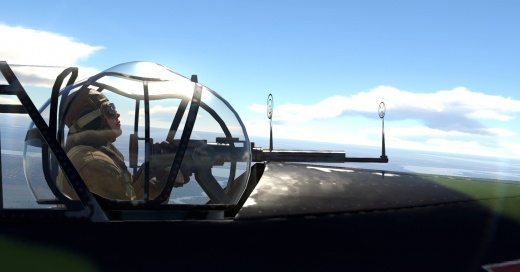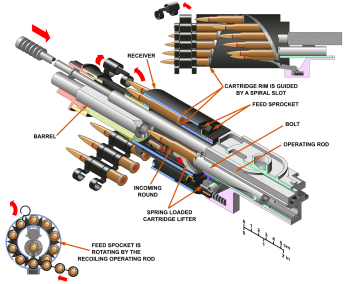Difference between revisions of "ShKAS (7.62 mm)"
m (Edits.) |
(Added analogues to the ShKAS) |
||
| Line 77: | Line 77: | ||
=== Comparison with analogues === | === Comparison with analogues === | ||
| − | ''Give a comparative description of cannons/machine guns, that have firepower equal to these type of weapons.'' | + | <!--''Give a comparative description of cannons/machine guns, that have firepower equal to these type of weapons.''--> |
| + | * Vickers F (7.7 mm) | ||
| + | * [[Darne 1933 (7.5 mm)]] | ||
| + | * [[Browning (7.62 mm)|Browning M1919 (7.62 mm)]] | ||
| + | * ShVAK (12.7 mm) | ||
| + | * [[Browning M2 (12.7 mm)|Browning AN/M2 (12.7 mm)]] | ||
| + | * [[MG 17 (7.92 mm)]] | ||
| + | * [[MAC 1934 (7.5 mm)]] | ||
== Usage in battles == | == Usage in battles == | ||
Revision as of 03:24, 21 April 2019

Contents
Description

The ShKAS (7.62 mm) (Shpitalny-Komaritski Aviatsionny Skorostrelny or Shipitalny-Komaritski rapid-fire for aircraft – Russian: ШКАС - Шпитального-Комарицкого Авиационный Скорострельный) is a 7.62 mm caliber machine gun which was first produced in 1933 for usage in Soviet aircraft which saw action all the way through World War II in many of the fighters, attackers and bombers of the day. The ShKAS is a single chamber, gas-operated revolver-type machine gun in which a firing pin strikes the primer of the bullet in the chamber to fire the round.
Vehicles equipped with this weapon
General info
The designers Boris Shpitalniy and Irinarkh Komaritsky departed from traditional methods of feeding belt linked ammunition into the ShKAS and utilised a feed design nicknamed “bird-cage” or “squirrel-cage”[1]. Even declassified documents regarding the United State’s evaluation of the feed system stated, “…an interesting departure was made from the heretofore orthodox practice of feeding ammunition to a gun of this caliber [sic].” [2]
The ammunition belt enters the feed cage forward of the firing chamber. When the gun is fired, a gas piston actuates an arm connected to the cylindrical feed cage, rotating it one position to introduce the new bullet. As the feed cage (holding ten rounds) rotates a helical groove and guides the bullets rearward. Through this process of working the bullets rearwards, they are automatically delinked from the metal disintegrating link belt. The rounds make it to the final position at the bottom of the drum where they are then chambered into the receiver, ready to be fired.
One of the benefits of this feed system is during the camming of the rounds; there is relatively no drag on the ammunition allowing the gun to be fired at high rates of speed; however, prolonged actuation can provoke these guns to jam. Rates of fire could be regulated through changing of the holes in the gas regulator, three different hole sizes going from largest to smallest would slow down the rate of fire to a more moderate rate.
|
The ShKAS machine gun had a high rate of fire but it also had 48 ways of jamming. Some of them could be fixed immediately, some could not. And 1,800 rounds a minute was an insanely high rate of fire. If you pulled the trigger too long, the ShKAS would fire all its ammo in one go and that would be it!![3]
|
Available shells
- Default (T/Ball/Ball/AP-I/AI)
- Universal (AP-I/AI/API-T)
- Tracers (AP-I/API-T)
- Stealth (AP-I/AP-I/AP-I/AI)
Comparison with analogues
- Vickers F (7.7 mm)
- Darne 1933 (7.5 mm)
- Browning M1919 (7.62 mm)
- ShVAK (12.7 mm)
- Browning AN/M2 (12.7 mm)
- MG 17 (7.92 mm)
- MAC 1934 (7.5 mm)
Usage in battles
Describe the cannon/machine gun in the game - its distinctive features, tactics of usage against the main opponents. Please don't write a "guide" - do not impose a single point of view, but give the reader food for thought.
Pros and cons
Pros:
- The fastest firing rifle-calibre machine gun in WWII
- Every belt is extremely effective at causing fires on enemy aircraft (tracers and stealth are the most effective)
- Incredibly easy to knock out gunners and pilots on enemy aircraft (or exposed crew members on ground and naval forces)
- If fired in short bursts, most aircraft can make a belt last an entire game in realistic battle
Cons:
- Can easily jam. It is recommended to fire in bursts lasting no longer than one second
History
Examine the history of the creation and combat usage of this weapon. If the historical reference turns out to be too big, take it to a separate article, taking a link to an article about the vehicle and adding a block "/ History" (example: https://wiki.warthunder.com/(weapon-name)/History) and add a link to it here using the main template. Be sure to reference text and sources by using <ref>, as well as adding them at the end of the article.
Media
An excellent addition to the article would be a video guide, as well as screenshots from the game and photos.
See also
Links to the articles on the War Thunder Wiki that you think will be useful for the reader, for example:
- reference to the article about the variant of the cannon/machine gun;
- references to approximate analogues by other nations and research trees.
External links
Paste links to sources and external resources, such as:
- topic on the official game forum;
- encyclopedia page on the weapon;
- other literature.
| Aircraft machine guns | |
|---|---|
| USA | |
| 7.62 mm | Browning · M134 Minigun |
| 12.7 mm | GAU-19 · M2 Browning · M3 Browning |
| Germany | |
| 7.62 mm | MG3 |
| 7.92 mm | MG 15 · MG 17 · MG 81 |
| 12.7 mm | FN M3P |
| 13 mm | MG 131 |
| USSR | |
| 7.62 mm | DA · GShG-7.62 · PKT · PV-1 · ShKAS |
| 12.7 mm | A-12.7 · Berezin UB · TKB-481 · YaK-B |
| Britain | |
| 7.62 mm | FN 60.30 · L8A1 |
| 7.7 mm | Browning · Lewis · Vickers E · Vickers K |
| Japan | |
| 7.7 mm | Te-1 · Type 89 · Type 89 'special' · Type 92 · Type 97 navy |
| 7.92 mm | Type 1 · Type 98 |
| 12.7 mm | Ho-103 · Ho-104 |
| 13 mm | Type 2 |
| 13.2 mm | Type 3 |
| China | |
| 12.7 mm | QJK99-12.7-1 |
| Italy | |
| 7.7 mm | Breda-SAFAT · Lewis |
| 7.92 mm | FN Browning |
| 12.7 mm | Breda-SAFAT · FN M3M · Scotti |
| France | |
| 7.5 mm | Darne 1933 · Fabrique Nationale Mle 38 · FN Browning · MAC 1934 · MAC 1934T · Mle 33 · Mle 1923 |
| 7.62 mm | PKA |
| 7.92 mm | FN-Browning M.36 No.3 · FN-Browning M.36 No.4 |
| Sweden | |
| 7.7 mm | FN-Browning M.36 No.3 |
| 8 mm | Ksp m/22 · Ksp m/22 Fh · Ksp m/22 Fv · Ksp m/22-37 R |
| 12.7 mm | Akan m/39A · Akan m/40 · Akan m/45 · LKk/42 |
| 13.2 mm | Akan m/39 · Akan m/39A |
- ↑ [Ian V. Hogg (1978). The illustrated encyclopaedia of firearms. New Burlington Books. p. 279. ISBN 978-0-906286-41-8]
- ↑ [Chinn, George M. The Machine Gun, Vol II, Part VII. US Department of the Navy, 1952, p. 78-79]
- ↑ [Drabkin, Artem. The Red Air Force at War: Barbarossa and the Retreat to Moscow – Recollections of Fighter Pilots on the Eastern Front. Barnsley, South Yorkshire, UK: Pen & Sword Military, 2007. ISBN 1-84415-563-3]




